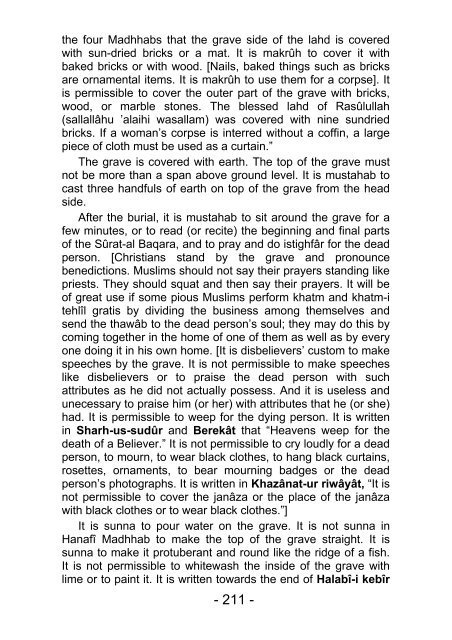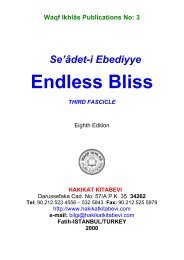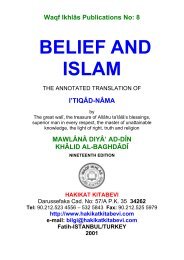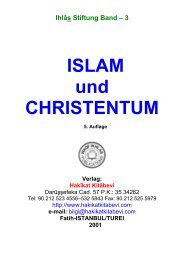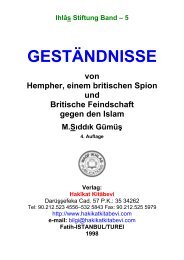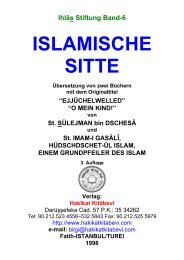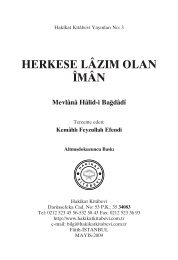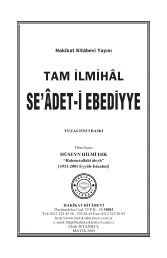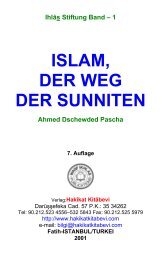5-Endless Bliss Fifth Fascicle - Hakikat Kitabevi
5-Endless Bliss Fifth Fascicle - Hakikat Kitabevi
5-Endless Bliss Fifth Fascicle - Hakikat Kitabevi
Create successful ePaper yourself
Turn your PDF publications into a flip-book with our unique Google optimized e-Paper software.
the four Madhhabs that the grave side of the lahd is covered<br />
with sun-dried bricks or a mat. It is makrûh to cover it with<br />
baked bricks or with wood. [Nails, baked things such as bricks<br />
are ornamental items. It is makrûh to use them for a corpse]. It<br />
is permissible to cover the outer part of the grave with bricks,<br />
wood, or marble stones. The blessed lahd of Rasûlullah<br />
(sallallâhu ’alaihi wasallam) was covered with nine sundried<br />
bricks. If a woman’s corpse is interred without a coffin, a large<br />
piece of cloth must be used as a curtain.”<br />
The grave is covered with earth. The top of the grave must<br />
not be more than a span above ground level. It is mustahab to<br />
cast three handfuls of earth on top of the grave from the head<br />
side.<br />
After the burial, it is mustahab to sit around the grave for a<br />
few minutes, or to read (or recite) the beginning and final parts<br />
of the Sûrat-al Baqara, and to pray and do istighfâr for the dead<br />
person. [Christians stand by the grave and pronounce<br />
benedictions. Muslims should not say their prayers standing like<br />
priests. They should squat and then say their prayers. It will be<br />
of great use if some pious Muslims perform khatm and khatm-i<br />
tehlîl gratis by dividing the business among themselves and<br />
send the thawâb to the dead person’s soul; they may do this by<br />
coming together in the home of one of them as well as by every<br />
one doing it in his own home. [It is disbelievers’ custom to make<br />
speeches by the grave. It is not permissible to make speeches<br />
like disbelievers or to praise the dead person with such<br />
attributes as he did not actually possess. And it is useless and<br />
unecessary to praise him (or her) with attributes that he (or she)<br />
had. It is permissible to weep for the dying person. It is written<br />
in Sharh-us-sudûr and Berekât that “Heavens weep for the<br />
death of a Believer.” It is not permissible to cry loudly for a dead<br />
person, to mourn, to wear black clothes, to hang black curtains,<br />
rosettes, ornaments, to bear mourning badges or the dead<br />
person’s photographs. It is written in Khazânat-ur riwâyât, “It is<br />
not permissible to cover the janâza or the place of the janâza<br />
with black clothes or to wear black clothes.”]<br />
It is sunna to pour water on the grave. It is not sunna in<br />
Hanafî Madhhab to make the top of the grave straight. It is<br />
sunna to make it protuberant and round like the ridge of a fish.<br />
It is not permissible to whitewash the inside of the grave with<br />
lime or to paint it. It is written towards the end of Halabî-i kebîr<br />
- 211 -


